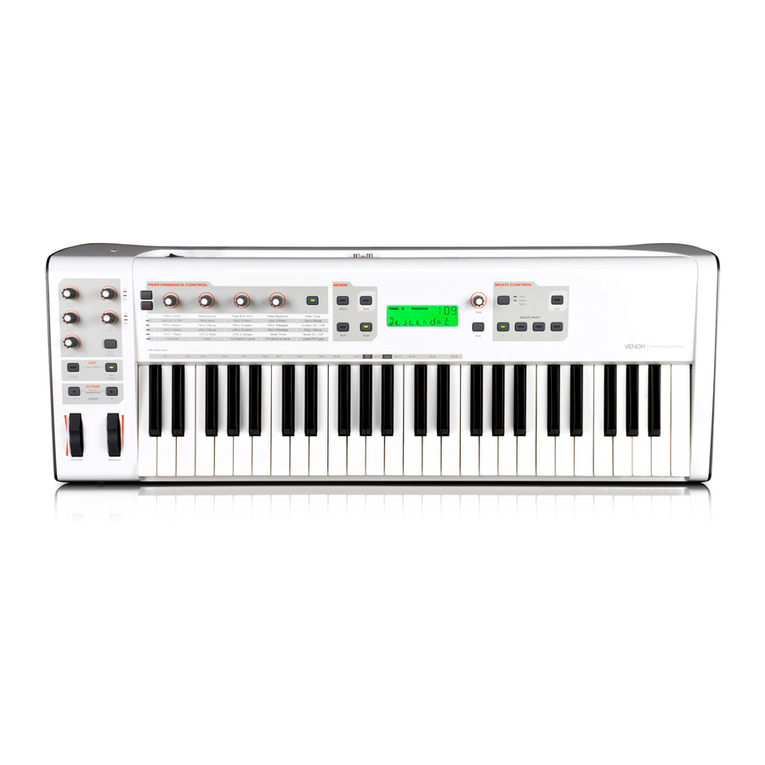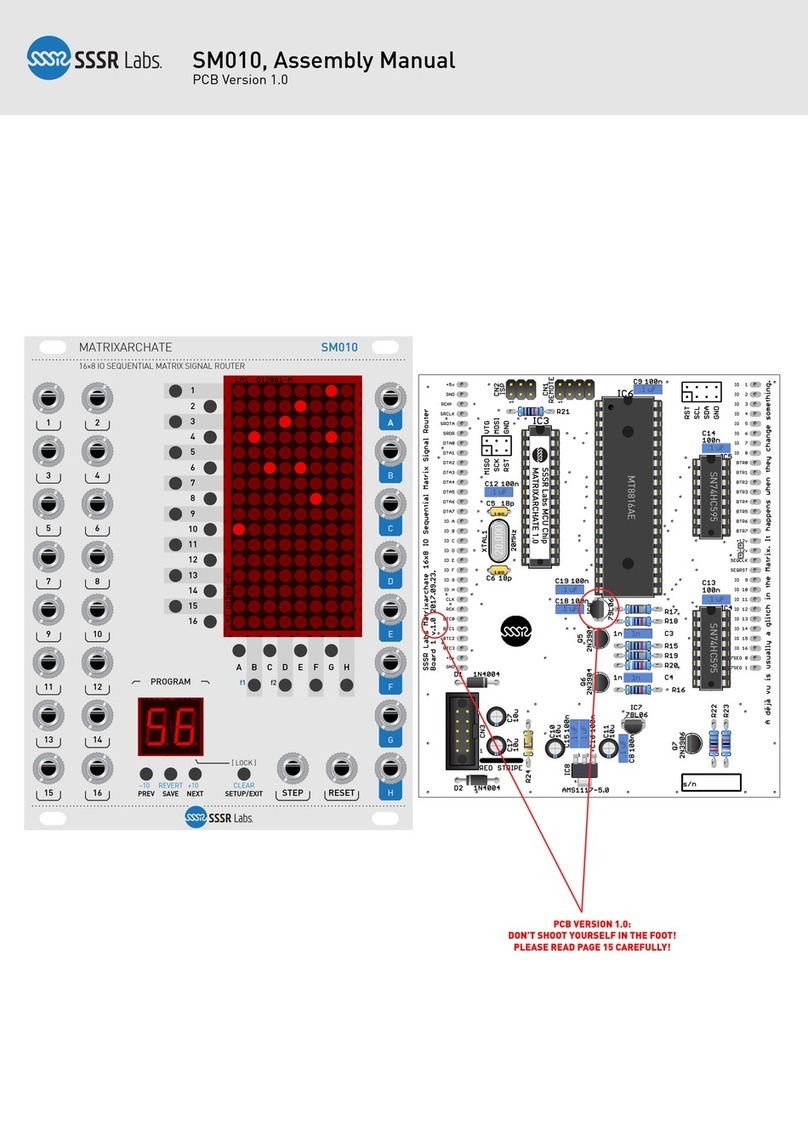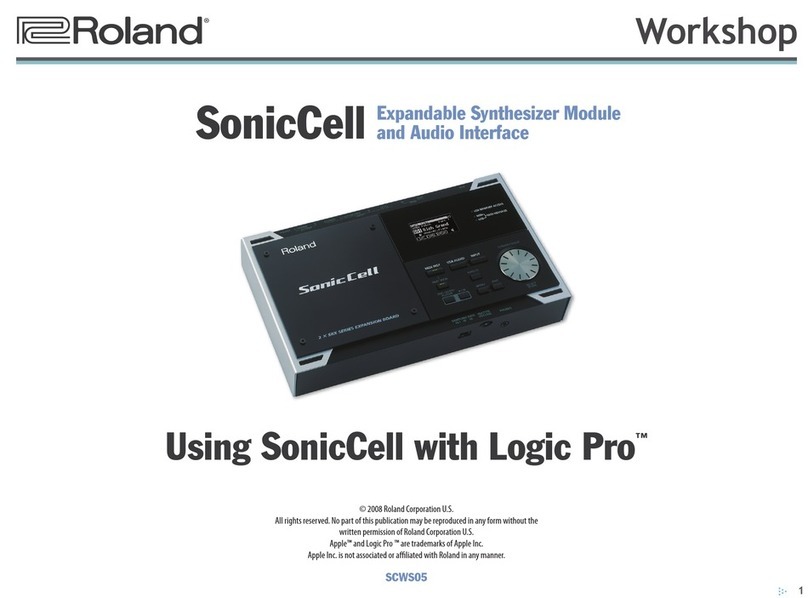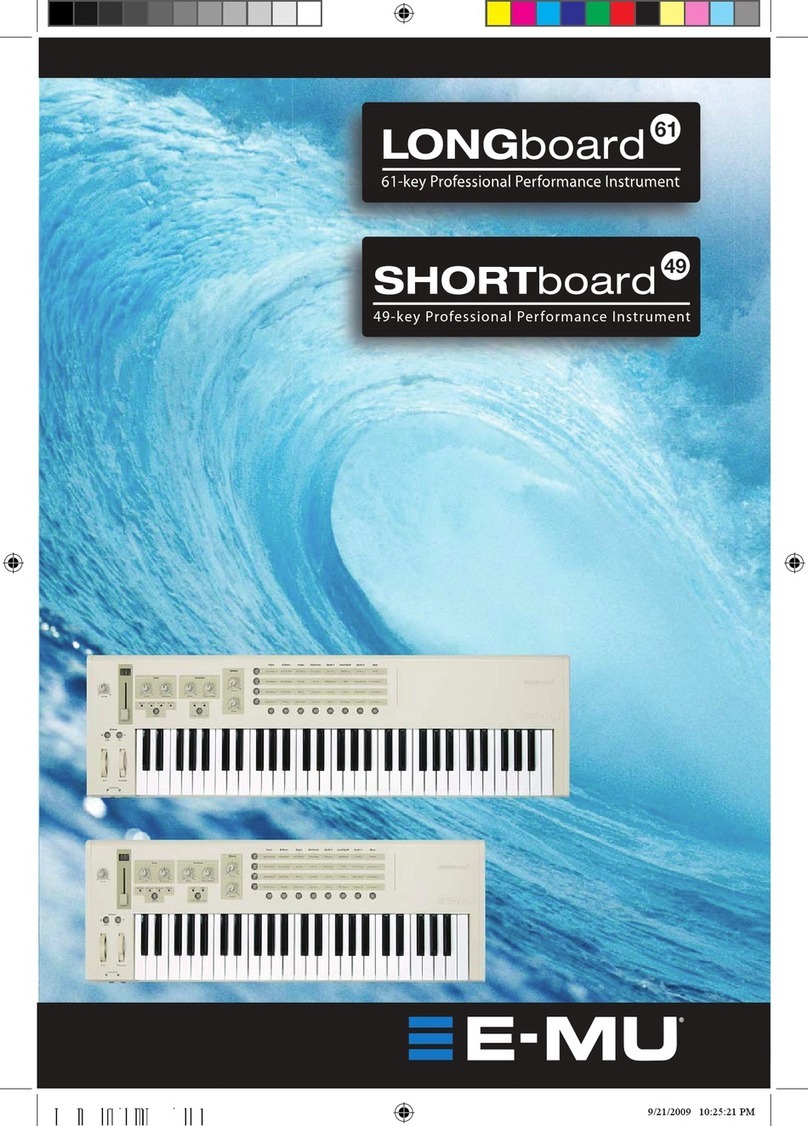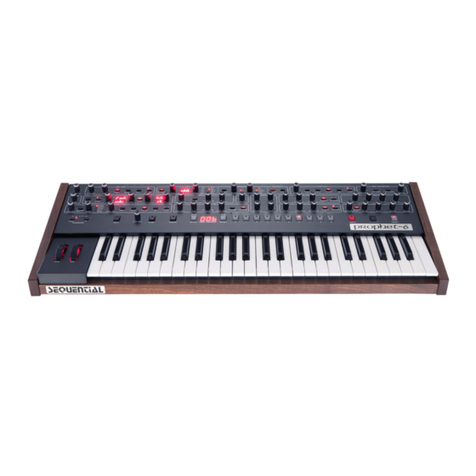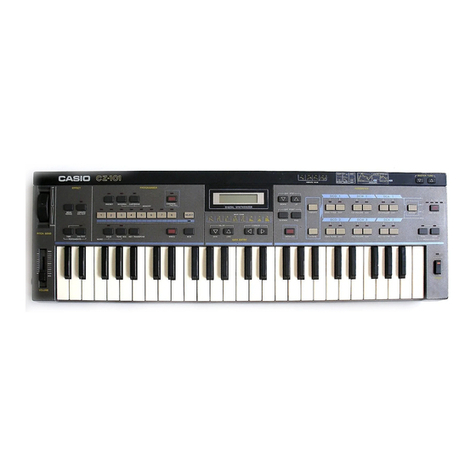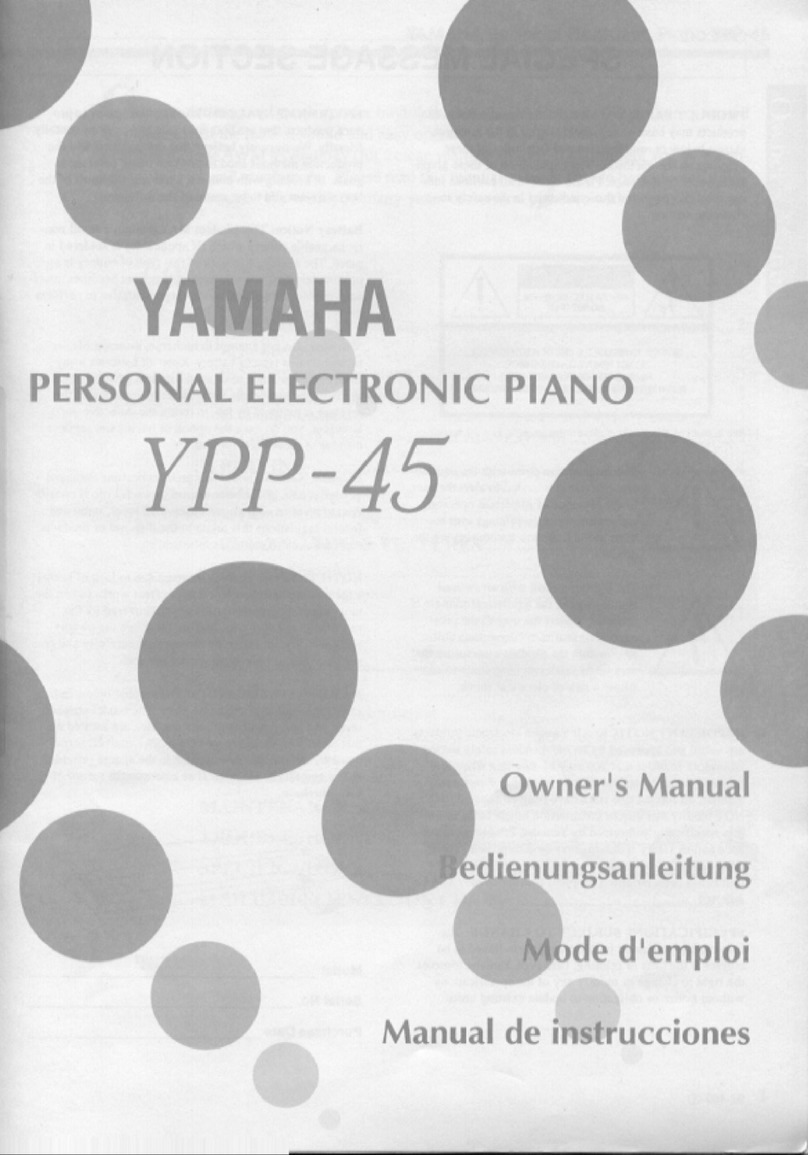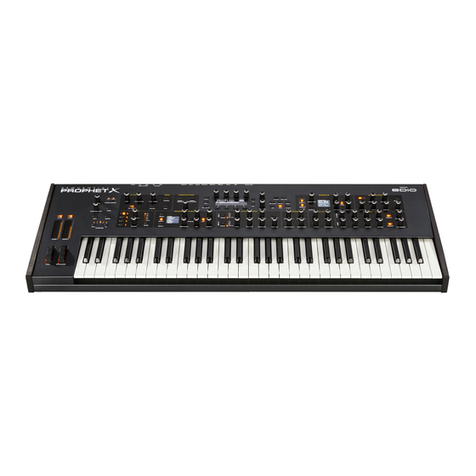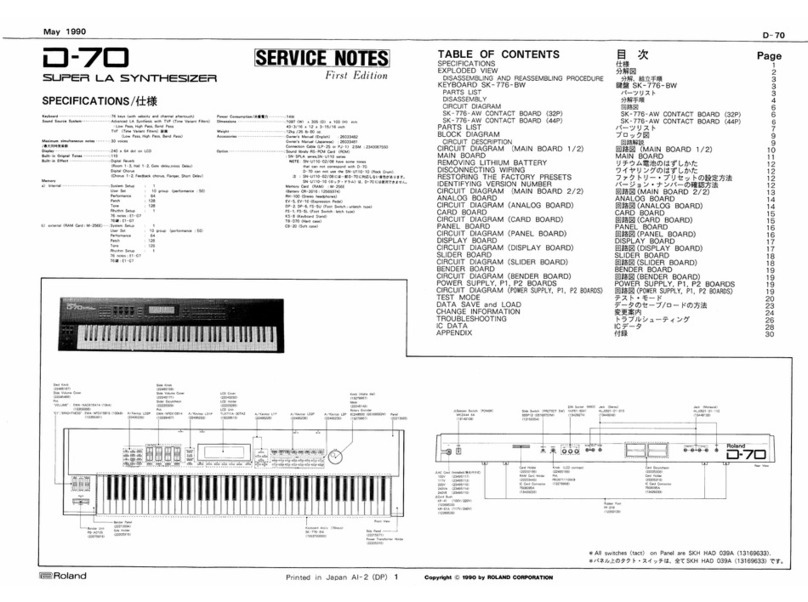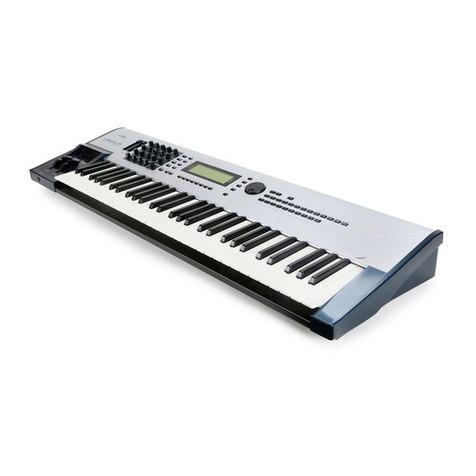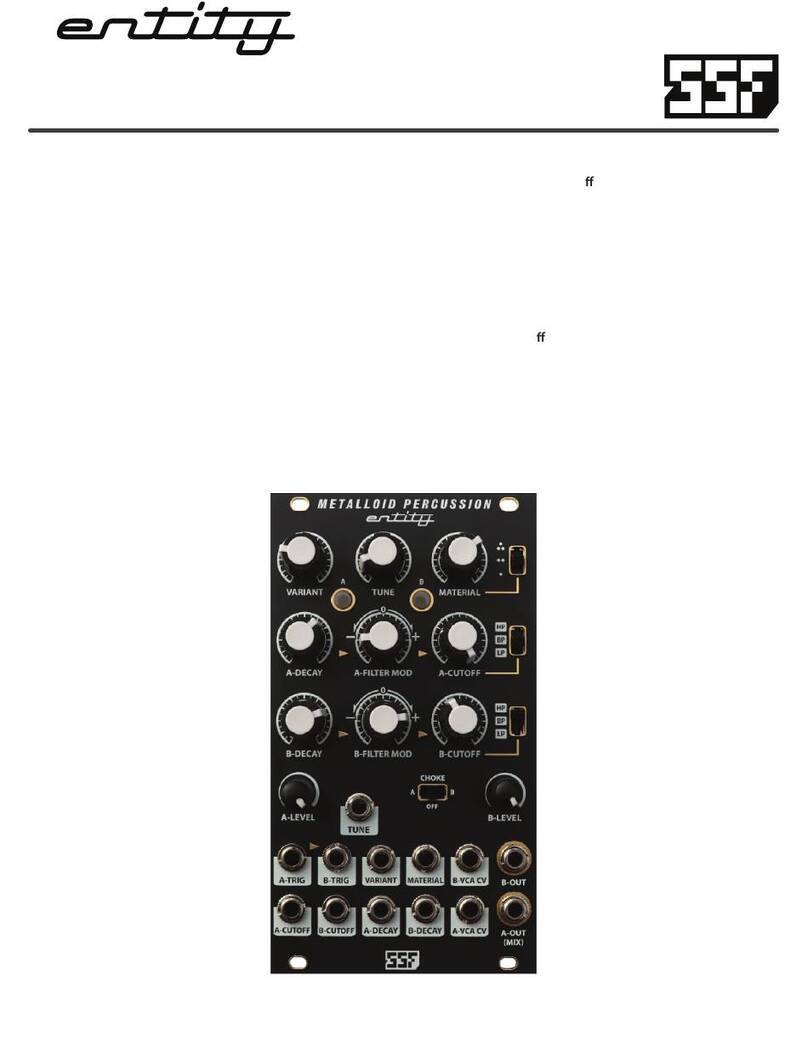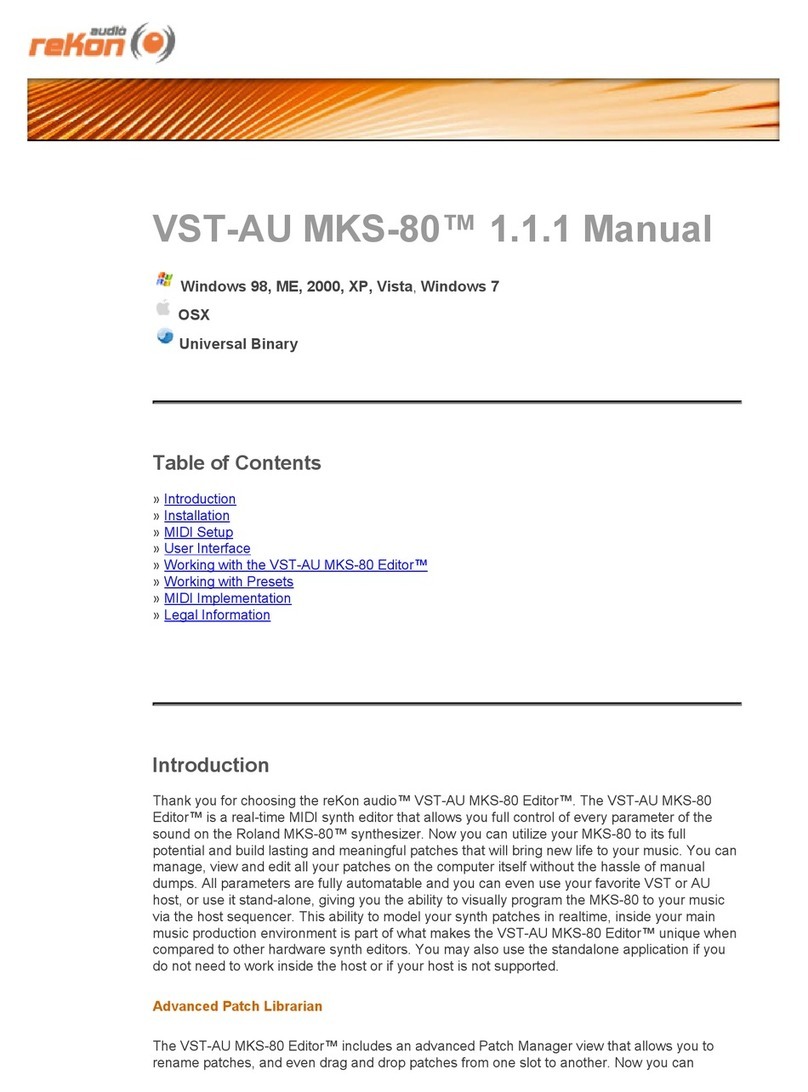RMI KC-II User manual

Rocky
Mount
instruments,
Inc.
Sales
Office:
Macungie,
Pa.
18062
Phone:
215/965-9801
Subsidiary
of
Alien
Orgsn
Company
©
1977
w&smg&m&tfQgsm
Wwsmm^^^mm-:
V
MODEL
kc-e
THE
FIRST
DIGITAL
POLYPHONIC
SYNTHESIZER

HEVBDflRD
CDMPUTER
Model
KC-11
Keyboard
Computer:
In
1974
musicians
hearing
the
Keyboard
Computer
for
the
first
time
responded
with
comments
like
"Astounding!"
or
"Can't
believe
it!"
The
Computer's
ability
to
polyphonically
generate
twelve
voices
simultaneously
added
to
the
excitement.
The
idea
began
to
catch
on.
Some
"big-name"
artists
picked
it
up.
Concerts,
record
albums,
and
two
years
later,
we
realized
the
sound
of
the
KC
was
here
to
stay.
It
was
time
to
create
KC-II.
Making
the
Computer
easier to
play,
we
added
a
new
Permanent
Voice
Memory
containing
popular
KC
sounds
of
the
past
few
years,
Presets
for
quick
changes,
a
few
extra
pedal
controls
for
further
flexibility,
and
Rocker
Controls
with
greater
function
description.
The
RMI
Keyboard
Computer
is:
NOT
a
Piano
. .
.
NOT
a
Synthesizer
.
.
.
NOT
an
Organ
The
Keyboard
Computer
Tone
Generation
System
has:
NO
Audio
Oscillators
. . .
NO
Formant
Filters
.
..
NO
Organ
Divider
Circuits
. . .
NO
Electro-Mechanical
Moving
Parts
.
. .
NO
Voltage
Controlled
Tracking
Trims
or
Op
Amp
Off-Set
Trims
...
NO
Critical
Periodic
Calibrations
to
be
Maintained.
The
RMI
Keyboard
is
truly
a
Musical
Digital
Computer:
If
a
sound
is
to
be
duplicated,
the
harmonic
content
of
its
waveform must
be
duplicated.
Filter
circuits
can
extract
waveforms
from
oscillators.
However,
filtering
is
largely
guesswork,
and
control
of
many
complex
waveforms
is
just
about
impossible,
as
anyone
familiar
with
synthesizers
will
attest.
A
more
predictable
method
has
arrived.
Allen
Organ
introduced
a
new
system
in
1971
to
be
shared
by
RMI—the
Musical
Digital
Computer.
The
principle
of
operation
is
similar
to
that
of
an
artist's
reproducing
an
enlarged
picture
on
a
billboard
employing
a
grid
of
squares
to
aid
their
accuracy.
The
waveform
to
be
reproduced
is
analyzed
on
a
graph.
Points
where
the
waveform
intersects
the
grid
are
assigned
numbers
and
the
numbers
are
stored
in
the
computer.
Reading
this
group
of
numbers
out
at
the
frequency
of
a
given
musical
pitch
regenerates
the
waveform.
This
concept
provides
an
order
of
accuracy
in
waveshape
control
never
before
achieved.
With
all
waveforms
reduced
to
a
series
of
numbers,
the
ability
to
repeat
a
given
sound
is
absolutely
precise
and
very
quick—a
feature
concert
and
studio
musicians
alike
will
appreciate.
To
indefinitely
expand
the
Com
puter's
tonal
range,
these
number
series
representing
waveforms
have
been
punched
on
standard
computer
cards—hundreds
are
available
from
an
ever
increasing
Tone
Card
Library
for
use
in
the
Computer's
Card
Reader.
The
most
popular
and
useful
sounds
have
been
stored
in
a
Permanent
Memory
LSI
device
that
can
be
activated
manually
or
by
Twelve
Presets.
Sounds
from
the
Permanent
Memory'and
Card
Reader
can be
mixed
in
any
combination.
Presets
allow
instant
change
of
contrasting
sounds:
Strings—musicians
who
have
heard
agree
nothing
else
approaches
the
realism
of
the
KC
strings.
Attack/
Decay
and
Vibrato
are
pedal-controlled.
Even
the
"bowing
noise"
is
heard.
Electric
Organ—tell-tale
sound
of
that
famous
electro-mechanical
organ
with
drawbars,
third
harmonic
percussion
and
two
speed
revolving
speakers.
Organ
and
Bells—Variable
with
foot
pedals
from
Bells
to
high-pitched
funky
organ
percussion.
Organ
and
Guitar—Stereo
effect.
Guitar
can
be
stylized
with.
Pitch
Bender
pedal
from
a
sliding
Pedal
Steel
to
Rock
Guitar.
Horn—mellow
and
rich
non-imitative
sound
good
for
jazz
work.
Electric
Piano—warm
and
realistic,
complete
with
sustain
pedal.
Clav—highly
characteristic.
Jazz
Flute
and
Clav—stereo
effect.
Jazz
Flute
complete with
"over-blow"
transients
due
to
"tongueing".
Alto
Recorder
and
Harpsichord—stereo
effect.
Exceptionally
delicate
and
articulate.
Bells—clanging
realism
due
to
KC's
forte
in
complex
waveforms
and
chorus
tuning.
Pipe
Organ—Diapason
Chorus
with
four-rank
Mixture.
Echo—notes
repeat
like
tape
echo,
but
in
a
different
tone
color
one
octave
lower.
Rate
is
pedal-variable.
Add
Manual—instantly
combines
manual
set-ups
with
presets.
Other
popular
set-ups:
#
Calliope
with
Chiff,
Cathedral
Choir,
Ring
Modulator
Gong,
Steel
Drum,
Sax
with
Random
Over-Blow
Effect,
Marimba,
Tubular
Chimes,
Assorted
Pulses
for
Funk
sound,
Several
Bell
effects,
Jaw
Harp,
Bagpipe,
Banjo,
etc.
Processors
Create
Contrasting
Voices
in
Stereo:
Twelve
independent
Digital
Voice
Processors
are
each
capable
of
generating
independent
frequencies,
attack/decay
envelopes,
and
waveforms.
Processors
can
be
assigned
to
the
keyboard
in
one,
two,
or
three-
to-a-key
modes
for
multiple
voice-per-key
effects.
Processors
can
be
split
in
Stereo
for
contrasting
effects—
example:
Alto
Recorder
vs.
Harpsichord.
Groups
of
Processors
can
be
assigned
various
pitch
deviations
such
as
Chorus
Tuning
or
Vibrato.
Chorus
Tuning
is
a
phenomenon
of
acoustic
instruments
due
to
slight
"imperfections"
in
tuning—slight
beats
are
heard
between
two
notes
closely
in
tune.
Envelope
Controls
Provide
a
Degree
of
Sophistication
beyond
Synthesizers:
Digital
Envelope
Generation
provides
a
stop-motion
feature
freezing
a
note
or
chord
while other
notes
or
chords
can
be
played
independently—handy
for
multiple
keyboard
performers
who
need
a
sustained
chord
on
one
instrument
while
playing
another.
Successive
chords
can
be
cross-faded
or
latched
at
any
point
in
the
fade.
Percussion,
Sustain,
or
Variable
Attack/Decay
can
be
assigned
to
different
groups
of
Processors
for
multiple
envelope
effects
in
Stereo.
Scaled
Attack/Decay
is
an
effect
musicians
have
grown
to
expect
from
acoustic
instruments—higher
pitched
notes
are
faster
and
lower
notes
are
slower
due
to
physical
size
and
resonance
of
the
instrument
(example:
Tuba
vs.
Piccolo).
The
KC
offers
two
different
curves
of
Scaled
Attack,
one
Scaled
Decay
curve,
a
Pedal-Variable
Attack/Decay,
or
an
abrupt
Staccato
Attack/Decay
for
funky
playing.
Certain
envelopes
can
be
Delayed
for
Echo
effects.
Pedal
Assembly
Provides
Expression
and
Flexibility:
When
both
hands
are
busy
at
a
Polyphonic
keyboard,
Pedal
Controls
become
an
absolutely
necessary
part
of
expression;
therefore,
RMI
includes
its
pedal
assembly
at
no
extra
charge.
Volume
Pedals
control
the
left
and
right
Stereo
Channels
independently.
Length
of
Percussion,
Sustain,
and
Variable
Attack/Decay
Modes
are
pedal-controlled.
Pitch-Bending
a
Perfect
Fourth
sharp
or
flat
is
controlled
by
a
spring-loaded
pedal
to
assure
return
to
standard
pitch.
Sustain
Latch,
Staccato
Mode,
Percussion,
and
Sustain
are
footswitch
controlled.
Vibrato
intensity,
a
critical
factor
in
music,
varies
from
none
to
a
shaking
synthesizer
effect
with
the
Vibrato
Pedal.
RMI
is
famous
for
its
Rugged
Construction
and
Quality:
Feel
it.
Lift
it.
Rap
on
the
case—tough!
Check
out
our
legs—sturdy,
but
easy
to
set
up.
Open
the
lid
and
look
inside—notice
the
neatness?
Feel
the
natural
wood
key
action
with
individually-adjustable
tension,
travel,
and
point-of-contact—we
build
it
ourselves.
Tilt
the
Rocker
Controls—notice
the
feel?
Rocky
Mount
Instruments
are
built
to
last.
Package:
High-impact
molded
case
withstands
rough
handling
on
the
road.
Keyboard
and
controls
have
locking
cover.
Case:
height
9-3/4"—width
44"—depth
24-1/2"—weight
99
lbs.
Four
heavy
chromed
steel
legs
unfold
adding
26-3/4"
to
total
height.

MODEL
KEVBDflRD
hC-H
CDMPJTER
FROM
THE
COMPANY
WITH
EXPERIENCE
IN
DIGITAL
POLYPHONIC
SYNTHESIS
RMI
PIONEERS
DIGITAL
SYNTHESIS
Forgotten
the
last
time
you
used
a
mechanical
adding
machine?
That's
because
everything
is
going
DIGITAL!
The
reason—a
desire
for
increased
accuracy
inherent
in
digital
systems
and
high
function
density
in
a
small,
reliable,
and
economical
package.
Articles
have
proclaimed
digital
synthesis
as
the
ultimate
musical
instrument
system
of
the
future.
RMI
is
in
that
future
NOW
and
it
works!
Since
1971,
our
parent
company,
Allen
Organ,
has
been
marketing
musical
instruments
relying
exclusively
upon
digital
waveform
generation.
This
experience
has
given
RMI
the
knowledge
to
build
a
reliable,
easily
playable,
and
highly
musical
instrument
with
sounds
musicians
are
seeking.
You
will
find
other
companies
just
beginning
to
experiment
while
RMI's
digital
ability
is
already
well-established.
NEW
TONAL
FREEDOM
Free
from
sawtooth
or
pulse
wave
"mother
tones" of
earlier
synthesizers,
RMI's
digital
system
can
create
a
wider range
of
timbres
with
greater
precision
and
absolute
repeatability
Controls
are
binary—on/off.
Gone
are
the
approximations,
cr.t.ca
adiustments
and
unrepeatable
"patches"
associated
W!th
slidepots
and
knobs.
Even
the
most
complex
effects
are
quick
and
exact.
DIGITAL
WAVEFORM
GENERATION
An
order
of
accuracy
in
control
never
before
achieved.
To
control
sound
is'to
control
waveshape.
Therefore
better
^
waveshape
control
means
better
sound
control.
KC-II
^
employs
no
audio
oscillators.
Instead,
wqyeferms
are
pbtted
on
an
amplitude-versus-time
graph.
Points
of
intersection
1
on
this
grid
are
assigned
binary
code
numbers
representing
\,
Jj*e
^F^0™11'
^ven
$?
fn°s*
complex
waveshapes
can
be
"frozen"
for
accurate
reconstruction
at
a
Uiter
date.
By
reading
out
the
entire
group
of
numbers
dnd
translating
^
them
into
relative
voltages,
at
a
rate
of
440
times
per
second,
for
example,
a
tone
of
middle
"AV
can
be
generated.
This
tone
will
exhibit
all
timbre
quality
inherent
in
the
waveshape.
Timbre
can
remain
stable
regardless
of
frequency
(pitch).
Tracing
problems,
along
with
filters,
are
eliminated.
A
whole
new
world
of
exotic
sounds
opens
up
born
realistic
and
•
^
-
—
■■■■»
ik
''■■■■■■■■■■■■■■■■■Si
PERMANENT
WAVEFORM
MEMORY
Years
were
spent
working
with
musicians
developing
timbres
constituting
useful
and
popular
sounds.
These
timbres,
represented
by
38
individual
waveforms
in
binary
code,
have
been
permanently
stored
in
the
memory
of
KC-II.
In
live
performance,
these
waveforms
can
be
recalled
instantly
either
individually
or
mixed
in
groups:
^:%i
t««
^Lk"'J~-
*
--
^^"^-"^"i-r"^*"?"'1***
wi
luui
rapid
availability
-ri
of
P<»agedf^sioui^:r^e^
^|
grounded
by
feeJ^ti^f^dditfenally,^
don't
want
^1
me
sounds
of
76juCm^n^;^
adventof
nex|
y
earVmodel.
Alterable
Voicci
Programming
v%j
.
solves
both
proplefi^^i^niSptidal
reader
accepts
Tone
'
t'v
":-^;;'
Cards
which
contain;bmc^»|*es
represenHng
waveforms?
?1
A
total
of
fcur
wrdscinbS:programmed.
:Once
programmed/:]
these
additional
wavef^fcehave
just
like
the
permanent
."M
m^T^!7
C?W?-b°
US^
^^dually'
*n
9roups,
or
mixed
?\;
with
the
permanent
memory^
Waveforms
in
any
combination.
;
?
Programming
can
be
up-dated
by
merely
slipping
another
%
lone
Card
in
and
out.
!:■.-•
-
- -
TONE
CARD
LIBRARY
Our
Tone
Card
Library
is
to
the
musician
what
a
paint
store
is
to
an
artist—it
contains
the
materials
in
raw
form.
Currently,
cards
number
in
the
hundreds
with
new
sounds
and
variations
under
continual
development.
Each
card
contains
not
only
timbre
information,
but
also
precise
amplitude
(R.M.S.
value)
and
pitch
data.
Many
cards
are
available
in
multiple
amplitudes
for
mixing
a
wide
variety
of
relative
strengths.
As
many
as
20
pitch
references
are
available
from
16'
through
1/2'
and
including
such
esoteric
fractions
as
2
2/7',
1
5/11',
and
8/9'.
Creativity
potential
is
staggering.
TWELVE
INDEPENDENT
DIGITAL
ENVELOPE
GENERATORS
Substantially
increased
control
and
musical
merits
are
gained
over
voltage-controlled
predecessors
while
critical
calibrations
are
eliminated.
Envelopes
are
plotted
on
amplitude-versus-
time
grids
much
like
our
digital
waveforms.
As
attack
and
decay
stages
are
"clocked",
amplitude
values
rise
and
fall
in
precise
sequence
creating
envelope
curves.
Several
independent
curves
including
an
abrupt
gating
can
be
selected
in
combinations.
Envelope
timing
can
occur
from
two
sources:
1.
Variable
Rate
Pedal
2.
Key
Frequency
(scaled
attack/decay:
high
notes
speak
quickly,
low
notes
speak
slowly—12
independent
rates
possible
simultaneously)
Clocking
sources
can
switch
automatically
while
crossing
from
attack
to
decay
ramps
or
upon
key
release.
Also,
clocking
can
be
stopped
on
specific
voices
to
create
"drones"
while
others
are
free
to
play.
Envelopes
can
be
mixed
to
obtain
more
complex
curves
or
even
envelope
timbral
changes.
Total
independent
polyphony
and
creativity
extend
well
beyond
familiar
ADSR
devices.
NATURAL
NOISES
IN
ACOUSTIC
INSTRUMENTS
Noises
are
a
natural
inherent
characteristic
of
acoustic
instruments:
the
squeak
of
round-wrapped
guitar
strings,
the
"chiff"
of
flutes
and
organ
pipes,
valve
noises,
air noises,
etc.
Musicians
have
become
accustomed
to
hearing
these
noises
integrated
with the
sounds
of
acoustic
instruments.
Remove
these
noises
and
the
resulting
sound
will
be
unnatural—too
perfect
or
sterile.
Digital
waveforms
and
envelopes
integrate
certain
subtle
noises
with
the
playing
of
each
note
for
a
natural
sound.
As
a
result,
KC-II
seems
to
"breathe"
when
played.
Cello,
viol,
or
any
bowed
string
is
another
example
of
this
noise
phenomenon.
A
well-rosined
bow
is
sticky.
Now
notice,
like
the
bow,
the
long
attack
ramp
in
the
envelope
graph
is
not
smooth.
There
is
a
remarkable
similarity
in
the
subtle
noises
generated
by
the
bow
and
slower
digital
envelopes.
This
factor
adds
to
the
excellence
of
the
KC-II
strings.

SCALED ENVELOPES
Scaled
envelopes
are
a
natural
phenomenon
found
in
acoustic
instruments.
High-pitched
instruments
(example:
piccolo,
violin)
tend
to
exhibit
rapid
attacks
and
decays
due
to
their
small
physical
size.
However,
a
large
tuba
or
bass
viol
would
be
much
slower
since
it
takes
time
for
the
air
inside
the
case
to
begin
oscillation.
Once
set
in
motion,
and
due
to
case
resonances,
oscillation
continues
slightly
beyond
the
time
when
the
stimulus
(blown
air,
bowing,
etc.)
is
removed.
A
large
chord
played
on
KC-II
could
have
as
many
as
twelve
different
attack
and
decay
rates
simultaneously.
This
feature
lends
great
plausibility
to
orchestral
effects.
AUTHENTIC
BOWED
STRINGS
POLYPHONIC
VOICE
ASSIGNMENT—
12
VOICES
There
is
no
"free
lunch":
the
more
you
spend
for
each
voice
generating
unit,
the
more
sophisticated,
flexible
and
better
sounding
it
can
be.
Therefore,
among
keyboards
in
the
same
financial
ballpark,
those
with
more
voice
generators
will,
of
necessity,
have
less
control,
and
those
with
fewer
voice
generators
can
afford
more
control
(over
each
sound).
Also,
the
least
control
will
come
from
systems
whose
generators
are
hard-wired
to
each
key—one
for
every
note.
Such
systems
are
inflexible
and,
in
essence,
are
filtered
organs.
For
example,
when
playing
a
6-note
chord
on
a
61-note
organ
approximately
9/10's
of
the
tonal
resources
are
lying
dormant.
The
longer
the
keyboard,
the
more
generators
wasted.
When
you
are
paying
for
each
generator,
you
want
a
more
cost-effective
system.
RMI
has
a
new
approach.
Survey
your
manual
anatomy—ten
fingers?
KC-II
provides
twelve
voice
generators
(two
more
than
you
have
fingers).
In
fact,
you
probably
average
somewhere
between
four
and
six
voices
at
a
time
in
most
music
(Bach
did
well
with
four).
Many
interesting
effects
and
"fat"
sounds are
created
by
having
multiple
voices
on
each
key.
Dividing
our
twelve
voices
between
Divisions
A
and
B,
A
and
C,
or
A,
B,
and
C
allows
one, two,
or
even
three
voices
per
key.
Selecting
the
proper
assignment
mode
for
your
music
will
keep
most
of
the
voices
speaking
most
of
the
time—an
efficient
use
of
your
tonal
resources.
Now,
even
simple
chords
can
create
big,
rich,
and
complex
sounds.
per
Key
(Total
=
12
Voices
from
12
Keys)
Division
A
12
Trumpets
Channel
One
(left
audio)
Division
A
6
Violins
Channel
One
(left
audio)
Tunings
"A"
440-
Division
B
6
Violins
Channel
Two
(right
audio)
Tuning:
"A"
442
per
Key
(Total
=
12
Voices
from
6
Keys)
I
CHAN.
1
I I
CHAN.
2
I
DIGITAL
CHORUS/VIBRATO
One
of
the
beauties
of
acoustic
instruments
is
their
slight
imperfection
in
pitch
when
played
in
ensemble.
KC-II
has
stored
this
"imperfection"
precisely
for
recreation
of
the
phenomenon.
Chorus
de-tuning or
digital
vibrato
can
be
selected
individually
for
Divisions
A,
B,
or
C.
Channel
One
can
have
vibrato
on
a
Flute
Solo
while
non-vibrato
Bells
emanate
from
Channel
Two.
Both
digital
and
master
pedal
vibratos
are
synchronized
and
rate
adjustable
Division
C
4
Bolls
Channel
Two
(right
audio)
Percussion
Envelope
Division
A
.
4
Organ
Pipes
Channel
One
(left
audio)
Tuningi
"A"
440
\
Division
B
.
4
Organ
Pipes
Channel
Two
(right
audio)
Tuning:
"A"
442
Three
Voices
Key
(Total
=
12
Voices
from
4
Keys)
ASSIGNMENT
EXAMPLES
CONTRASTING
VOICES-
LIVE
PERFORMANCE
FLEXIBILITY
Predictable
and
accurate
control
over
quick
changes
is
the
secret
to
live
performance.
KC-II
provides
much
of
the
flexibility
of
double
keyboards:
contrasting
envelopes
and
waveshapes
can
be
assigned
opposite
audio
channels
for
rapid
control
with
pedal
faders.
Contrasting
effects
can
even
be
mixed
in
a
single
channel
with
a
third
effect
on
the
opposite
channel,
keeping
your
audience
guessing.
Fat
and
rich
bass
lines
from
the
lower
end
of
the
keyboard
are
available
simultaneously
with
clean
and
brilliant
chords
or
lead
lines
from
the
upper
end—all
without
split
keyboard
problems.
Digital
waveforms
make
it
possible.
CHORUS
TUNING
» ♦
♦
LEFT
AUDIO
A44O
TUNING
A442
TUNING

PRESETS
ALLOW
RAPID-FIRE
CHANGES
Strings—typical
electric
string
machines are
buried
in
the
mix
while
KC-ll's
realism
merits
solo
work.
Proper
waveshape
maintained
to
the
extremities
of
the
keyboard
and
independent
envelopes
contribute
authenticity.
Details
such
as
variable
phrased
vibrato
and
variable
attack/decay
(pedals)
are
musically convincing.
Even
string
pizzicato
can
be
added
by
footswitch.
Chords
can
be
"latched"
to
free
hands.
"Bowing
noise"
is
the
final
touch.
Electric
Organ—the
old
tone-wheel
and
drawbars
sound
has
been
captured complete
with
third
harmonic
percussion
and
two-speed
rotary
speakers.
Staccato
footswitch
is
percussion
cancel.
Vibrato
pedal
is
tremolo
control.
Organ
and
Bells—very
commercial.
1'
sine
tone
pedal
variable
from
long
wailing
sustained
percussion
to
a
short
funky
"popcorn"
percussion—all
on
top
of
an
organ
sound.
Organ
and
Guitar—B-3
effect
in
Channel
One
with
pedal
steel
or
rock
guitar
in
Channel
Two.
Pitch
Bender
creates
slides
up
to
a
fourth.
Pedal
faders
make
rapid
changes.
Horn—Rich,
fat,
and
breathy..
Scaled
attack/decay.
Just
the
raw
material
for
"synthesizer
licks"
(pitch
bends
and
vibrato).
Addition
of
percussion
pedal
creates
piano.
Electric
Piano—8'
transpose
is
warm
and
realistic
with
sustain
pedal.
16'
takes
on
an
electric
bass
in
lower
end.
Latch
pedal
creates
a
mellow
organ
or
holds
notes
or
chords
while
the
remainder
of
the
keyboard
is
free.
Clav—funky
metallic
sound
(very
popular).
Decay
is
pedal-variable
from
"loose"
to
"tight".
Jazz
Flute
and
Clav—highly
realistic
metal
flute
contrasts
clav
in
opposite
audio
channel.
Alto
Recorder
and
Harpsichord—wood
flute
contrasts
plucked
strings
in
opposite
audio
channels.
Exceptionally
delicate
and
articulate.
Bells—clanging
realism
due
to
KC-ll's
forte
in
complex
waveforms
and
chorus
tuning.
Decay
is
pedal-variable.
Pipe
Organ—diapason
chorus
with
4-rank
mixture.
The
Allen
Organ
heritage
shines
here.
Echo—notes
repeat
like
tape
echo,
but
in
a
different
timbrr
one
octave
lower.
Delay
time
is
pedal-variable.
CUSf0M^5ET-UPSrf
DO-IT-YOURSELF
SOUNDS
While
playing
on
a
preset,
you
can
create
your
own
sounds
one
tab
at
a
time.
When
ready,
turn
off
the
preset
and
your
custom
sound
is
on
(presets
override
custom
set-ups).
For
further
flexibility,
your
custom
sounds
can
be
added
to
any
preset
with
the
Add
Manual
tab.
You
can
play
non-stop
for
hours
continually
changing
to
new
effects.
Our
comprehensive
Owner's
Manual
currently
contains
over
50
creative
"patches".
Some
of
the
favorites
are:
Sax
with
random
over-blow,
Vibes,
Marimba,
Steel
Drum,
Banjo,
Dynamic
Brass
(timbral
change),
Honky-Tonk,
Choir,
and
Abstracts.
~-
.
PEDAL
ASSEMBLY
IS
INCLUDED
With
a
Polyphonic
Synthesizer,
serious
professional
keyboard
people
concentrate
on
their
music
with
both
hands
on
the
keys.
Attempts
at
reaching
for
controls
destroy
the
natural
flow.
Therefore,
musical
expression
such
as
Pitch
Bend,
Vibrato,
etc.,
must
come
from
the
feet.
KC-ll's
Pedal Assembly
is
included
as
an
integral
part
of
the
instrument,
not
an
accessory.
Musicians
will
find
KC-II
a
full-time
instrument—much
like
driving
a
sports
car.
Tooling
through
your
licks
takes
on
new
expression.
Envelopes
can
be
compressed
or
expanded
right
in
the
middle
of
your
most
difficult
runs.
KC-II
responds
as
an
extension
of
your
body.
PLUG-IN
CIRCUITRY
0J£our
belief
that
a
musician
who
iipalces
a
substantial
investment
in
Ja/najor
keyboard
relies
upon
that
^fcfrument.
Expensive
and
lengthy
jSdown
time"
on
the
job
is
;
intolerable.
KC-II
functions
are
gd$y|ded
into
five
plug-in
boards,
^ifce
event
of
failure,
a
quick
^exchange
plugs
you
back
in
business.
Pictured
on
the
right
is
^our
main
computer
board—a
"chip"
foff
the
old
block
below.
Rocky
Mount
Instruments,
Inc.,
Sales
Office:
Macungie,
Pa.
18062,
Subsidiary
of
Allen
Organ
Company
/
VARIABLE
\
I
from
off
\
/
through
\
/CLASSICAL
STRINGS^
/
to
heavy
/
SYNTHESIZER
LICKS
yv-nerates
abrupt
attacks
&
decays
acts
as
an
envelope
modifier
acts
as
an
envelope
sub-preset
*
push
ON/OFF
with
L.E.D.
indicator
HOLES
\
assembly
so
peda/s
j
do
not
/
"walk
away"
/
during
/
performance
/
STEREO
FADERSl
cross
fade
\
from
I
organ
to
guitar
\
flute
to
clav
I
etc.,
or
'
add
them
together
CONTROLS:
~
^-^
variable
attack/decay
rate
percussion
decay
rate
S
sustain
decay
rate
yr
/
echo
delay
time
jS
/
jingle
notes or
chords
modifies
other
envelope
functions
cross-fades
preset
chords
push
ON/OFF
with
L.E.D.
indicator
/a
PERFECT
FOURTH
\
/
sharp
or
flat
spring
loaded
to
assure
return
to
standard
pitch
RMI's
FAMOUS
RUGGED
CONSTRUCTION
AND
QUALITY
Heritage
dates
back
to
1939
with
our
parent,
the
Allen
Organ
Company.
Musicians
are
the
benefactors.
The
same
quality
level
as
Allen
is
maintained
and
many
parts
are
identical.
For
example,
all
control
tab
legends
are
engraved.
Our
front
panel
is
routed
out
of
wood.
RMI
keyboards
are
literally
a
"piece
of
the
rock"
from
giant
four-manual
consoles.
Key
action
is
natural
wood
with
individually-
adjustable
tension,
travel,
and
point-of-contact.
Our
legs
are
sturdy,
but
quick
and
easy
to
set
up.
Expensive
extra
travelling
cases
are
unnecessary
with
RMI
because
we
build
our
instruments
into
an
enclosed
case.
We
invite
you
to
look
inside
any
instrument
before
you
buy,
particularly
ours—
you
will
see
the
difference.
Rocky
Mount
Instruments
are
built
to
last.
PACKAGE
.
Case:
height
9-3/4",
width
44",
depth
24-1/2'
Legs:
add
26-3/4"
to
height
Pedals:
height
3",
width
46",
depth
13"
Power:
90
watts
<Sb
117
vac—50/60
hz


7
*

Dear
KC-11
Owner:
Congratulations!
You
have
chosen
a
unique
instrument
that
will
no
doubt
cause
you
to
stand
out
as
a
musician.
Your
decision
to
purchase
the
Keyboard
Computer
was
probably
based
on
the
sounds
you
heard
either
on
the
demonstration
record
or
in
person
at
a
live
demonstration.
We
would
agree
that
the
sound
of
an
instrument
is
its
most
important
quality.
Instant-action
Presets
controlling
the
most
popular
sounds
allow
you
quick
access
to
a
wide
variety
of
effects,
how
ever,
the
potential of
this
instrument
extends
far
beyond
the
Presets.
We
would
like
to
see
you
realize
the
greatest
return
on
your
investment
by
exploring
the
total
potential
of
your
Computer.
This
Owner's
Manual
is
a
comprehensive
collection
of
data
gathered
over
a
period
of
years
beginning
in
1974.
Contributions
in
the
form
of
Set-Up
Sheets
and
ideas
have
been
made
by
owners
like
yourself.
Blank
Set-Up
Sheets
are
provided
for
your
convenience
to
jot
down
new
sounds.
If
you
create
some
new
Set-Ups
you
feel
are
unique,
please
send
them
our
way
-
the
Owner's
Manual
is
loose-leaf
and
we
up-date
it
from
time
to
time.
Finally,
if
you
are
to
realize
the
full
potential
of
your
KC-11
you
must
give
the
Owner's
Manual
a
thorough
reading
-
at
least
once.
There
is
much
more
to
the
Computer
than
meets
the eye
from the
front
panel.
Should
you
get
in
a
bind
understanding
some
part
of
the
instrument,
we
are
as
near
as
your
phone
(no
collect
calls,
please).
Enjoy
the
knowledge
that
your
sounds
will
eventually
affect
the
music
business
as
have
synthesizers.
Good
luck.
Sincerely,
Clark
A.
Ferguson
RMI
Performing
Artist

TABLE
OF
CONTENTS
Page
Subj
ect
1
INSTANT
KC-II
-
OR
HOW
TO
START PLAYING
IMMEDIATELY
WITHOUT
MUCH
READING
2
AUDIO
REQUIREMENTS:
"Flat"
Response
Type
of
Equipment
3
SETTING
UP
YOUR
KC
FOR
PERFORMANCE
7
RMI
360
SERIES
AMPLIFIER
AND
SPEAKER
SYSTEMS
11
KC
CONTROL
FUNCTIONS
-
BRIEF
DESCRIPTION
15
WAVEFORMS:
16
Tone
Card
Hole
Designation
(Clarinet
-
Wood
8T)
17
One
Cycle of
Clarinet
-
Wood
8!
MOOR1084
(graph)
18
Waveform
Symmetry
19
Tone
Card
Pitch
Control
20
PITCHES:
21
Pitch
Footage
Chart
22
Pitch
Characteristics
and
Usage
25
Pitch
Characteristics
and
Usage
Chart
27
FIXED
VOICES:
29
Fixed
Voices
Chart
30
TONE
CARDS:
R.M.S,
Values
31
Custom
Cards
Polic>
32
Current
RMI
Tone
Card
Library Categories
35
Mixing
Pulse
Waves
(graph)
36
Mixing
Pulses
to
Create
Staircase
Waveform
(graph)
37
Sax
Set-Up:
Random
Tone Change and/or
Octave
Jump
(graph)
38
VOICE
COMBINATIONS
(recommendations)
41
PROCESSORS
43
ENVELOPE
GENERATION:
47
Long
Attack/Normal
Decay
(graph)
48
Short
Attack/Normal
Decay
(graph)
49
Percussion
Decay
(graph)
50
CHANNEL
ASSIGNMENT
-
VOICES,
PROCESSORS,
5
ENVELOPES
(block
diagram)
51
Pitch
Generation
Add
Channel
Two
52
Chorus/Vibrato
53
Chorus
Effect
-
Divisions
"B"
5
f!C"
(panel
facsimile)
54
Envelopes

Page
Subject
54
Fixed
£
Alterable
Voices
55
Processors
56
PROCESSOR
AND
ENVELOPE
ASSIGNMENT
COMBINATIONS:
57
Recommendations
(panel
facsimile)
59
KEYBOARD
COMPUTER
TECHNIQUE:
60
Instrumental
Realism
Styles
61
Presets:
Strings
64
Electric
Organ
(B-3)
65
Organ
§
Bells
Organ
§
Guitar
67
Horn
68
Electric
Piano
69
Clav
Jazz
Flute
§
Clav
71
Alto
Recorder
§
Harpsichord
Bells
v
Pipe
Organ
72
Echo
74
THE
PEDALS:
Vibrato
Attack/Decay
75
Volume
Foot
Switches:
Latch,
Staccato,
Percussion,
Sustain
76
Pitch
Bender
Technique
78
Transposer
Tuning
§
Pitch
Bender
Controls
80
Model KC-II
Pitch
Bender
Controls
(schematic)
ORIGINAL
MUSIC
WRITTEN
FOR
KEYBOARD
COMPUTER
-
COMPOSED
BY
CLARK
FERGUSON
TRANSCRIBED
BY
RALPH
SPOETTLE
SET-UP
CHARTS
(panel
facsimiles):
The
12
Presets
-
Explanation
Add
Manual
-
For
Presets
Custom
Set-Ups
25
Blank
Set-Up
Sheets
SERVICE
MANUAL
-
SEE
TABLE
OF
CONTENTS
IN
SERVICE
MANUAL
SECTION

INSTANT
KC-II
—
OR
HOW
TO
START
PLAYING
IMMEDIATELY
WITHOUT
MUCH
READING
1.
Place
all
control
tabs
in
NORMAL
or
OFF
position
-
push
top
end,
2.
If
red
LATCH
or
STACCATO
lights
are
lit,
push
corresponding
foot
switch
to
cancel.
3.
Open
CHANNEL
1-2
and
CHANNEL
2
pedals
-
toe
down
all
the
way.
4.
Place
LEFT
FOOT
on
VIBRATO
pedal.
5.
Place
RIGHT
FOOT
on
ATTACK-DECAY
pedal.
(Do
not
allow
your
foot
to
catch
on
an
adjacent
pedal).
NOW,
YOU ARE
READY
TO
TRY THE
PRESETS
1.
Select one
preset
at
a
time
-
start
with
STRINGS.
2.
Use
3-voice
"open"
harmony
-
large
spaces
between
voices.
3.
Notice
you
hear
2
strings
playing
for
every
key you
hold
-
Chorus
Tuning.
4.
Adjust
ATTACK-DECAY
time
(right
foot)
while
repeating
a
chord
-
listen.
5.
Add
some
VIBRATO
(left
foot)
as
each
musical
phrase
builds.
6.
Try
TRANSPOSE
8
(under
GENERALS)
for
high
violins.
NOWf
YOU ARE
READY
TO
TRY
OTHER
PRESETS
1.
Notice
the
word
"priority11
and
an
arrow
to
the
right.
When
more
than
one
preset
is
turned
on,
the
one
farthest
to
the
right
will
be
in
operation.
2.
As
you
change
from
one
preset
to
the
next,
you
will
notice
that
adjustments
will
be
required
in
the
ATTACK-DECAY
time
(right
foot)
to
obtain
realistic
musical
results
-
experiment
with
extremes.
Some
presets
will
not
be
affected
by
the
ATTACK-DECAY
pedal:
Pipe
Organ
&
Clav.
3.
Some
presets
will
sound
best
with
VIBRATO
added
-
STRINGS
particularly.
4.
Some
presets
have
contrasting
instruments
in
Stereo.
Open
and
close
CHANNEL
1-2
and
CHANNEL
2
pedals
independently.
5.
Experiment
with
effects
LATCH,
STACCATO,
and
SUSTAIN-PERC
pedals
have
on
the
presets.
THERE
IS
A
LOT
MORE
TO
THE
COMPUTER
THAN
MEETS
THE EYE
So,
read
your
Owner's
Manual.

RMI
Keyboard
Computer
Audio
Requirements
Probably
the
most
unique
single
feature
of
the
KC is
its
ability
to
control
waveshape
and
thereby
control
even
the
most
complex
harmonic
content.
When
one
has
paid
substantially
for
such
an
instrument
that
can
generate
an
extremely
wide
range
of
sound,
it
would
follow
that the audio
system
through
which
you
will
hear
this
instrument
should
also
be
of
che
same
wide-range
calibre,
if you
are
to
hear
what
you
paid
for.
There
are
probably
numerous
excellent
systems
manufactured
by
many
companies
.
that
would
give
successful
results
with
the
KC.
Since
we
cannot
investigate
all
of
them,
here
are
some
general
guidelines
to
follow
to
make
your
own
choice.
The
KC
requires
"flat"
response.
An
absolutely
flat
system
would
respond
with
equal
efficiency
at
all
frequencies
of
the
audio
range.
The
term
Mflatlf
is
in
quotes,
however,
since
it
is
not
technically
possible
today
to
build
an
absolutely
flat
system.
This
need
not
become
a
problem,
but
instead
an
advantage.
The
most
critical
part
of
the
range
in
creating
the
realism
in
imitated
instruments
that
the
KC
is
so
famous
for
is
the
mid-range
and
upper
frequencies.
Frequencies
lying
in
this
area
must
remain
in
precise
and
proper
proportions
to
each
other
if
realism
is
to
be
achieved.
While
the
lower
end
is
certainly
important
to
high
fidelity,
if
lows
tend
to
roll
off
or
drop
out,
most
of
the
realism
will
still
be
present. The
lower
end
pro
vides
a
sense
of
power
-
the
listener
feels
the
results
on
the
floor
and
on
his
or
her
chest
and
it
adds
emotion
to the
music.
However,
in
many
situ
ations
where
KC
players
work
in
a
band,
there
is
a
bass
player
and
the
bass
portion
of
the
spectrum
is
delegated
to
that
instrument.
Since
the
KC
player
would
not
want
to
fight
the
bass
player,
a
drop
off
in
the
bass
range
of
the
KC
audio
system
is
a
definite
advantage
even
though
it
is
not
flat.
A
KC
performer
doing
a
solo
gig,
however,
would
want
plenty
of
bass
power
since
he
would
be
called
upon
to
create
his
own
bass
lines.
What
type
of
equipment
does
flat
response
require?
Almost
without
excep
tion
flat
response
requires
some form
of
multiple
speaker
system.
Due
to
efficiencies
and
inefficiencies
in
mechanical
design,
certain
types
of
speakers
are
more
efficient
operating
in
different
portions
of
the
audio
range.
Of
course,
the
end
result
is
to
have
the
entire
range
covered
with
equal
efficiency.
In
general,
larger
speakers
cover
the
bass,
medium
size

cover
the
mid-range,
and
very
small
ones
cover
the
upper
end.
No
company
has
ever
successfully
covered
the
entire
range
with
one
speaker.
Most
bass
speakers
are
of
the
paper
cone
variety,
and
a
very common
and
efficient
size
is
fifteen
inches.
These
speakers
must
be
mounted
in
one
of
several
types
of
cabinets.
Horn-loaded
cabinets
tend
to
be
very
efficient
by
nature
but
in
a
rather narrow
band
of
frequencies,
causing
a
"boominess"
quality.
Ducted
or
ported
cabinets
are
a
little
less
efficient,
but
their
efficiency
is
spread
over
a
wider
range
of
frequencies.
Finally,
sealed
or
flair-suspension!l
cabinets
offer
the
very
best
in
wide-range
coverage
of
the
bass
range;
however,
their
efficiency
is
very poor
causing
them
to
require
substantial
amounts
of
amplifier
power
for
the
same
volume
levels.
Mid-range
speakers
commonly
used
in
the
hi-fi
industry
are
also
of
the
paper
cone
type,
due
to
their
physical
ability
to
cover
a
given
range
with
relatively
equal
efficiency.
Such
devices
as
rubber or
cloth
edges
further
expand
range
and
ability
to
generate
transients
-
so
critical
to
percussive
attacks.
These
types
of
mid-range
speakers
are
generally
sealed
from
the
rear
and
therefore
do
not
react
with
the
cabinet
in
which
they
are
installed.
Horn-loaded
com
pression
drivers
(known
as
mid-range
horns) are
more
frequently
used
in
the
P.A.
and
musical
instrument
business
due
to
their
well-known
ability
for
penetration.
Once
again,
horns
are
highly-efficient
but
at
the
sacrifice of
wide
range
response,
although
some
people
will
tell
you
they
can
be
equalized
flat.
Solo
instruments,
guitar
and
voice
sound
okay
through
horns
due
to
the
fact
that
most
of
the
audio
being
generated
by
these
sources
falls
within
the
range
of
the
horn.
However,
full
range
instruments
like
the
KC
and
particularly
"string11
keyboards
sound
like
horn
or
brass
sections
when
heard
through
horns.
Avoid
using
horn
speakers
when
trying
to
achieve
flat
response
for
keyboards.
Tweeters
is
the
term
applied
to
upper
range
speakers
and
most
hi-fi
manu
facturers
again
stick
with
the
paper
cone
or
dome type
for
the
same
reasons
outlined
before.
Horn
tweeters
tend
to
become
"peaky."
When
choosing
the
speaker
system
for
your
KC,
checkout
the
types
of
speakers
used
and
how
many.
You
should
try
for
all
paper
cones
or
dome
type
(avoiding
horns)
and
try
for
at
least
a
three-way
system
-
bass
speaker,
mid-range
speaker,
and
tweeter.
Better
systems
will
usually
have
more
than
one
of
each
mid-range
and
tweeter.
If
you
are
in
doubt,
try
the
KC
Strings
Preset
through
the
system
you
are
considering.
Can
you
imagine
yourself
in
the

middle
of
a
real
string
quartet,
or does
it
sound
electrically
amplified?
Amplifiers
should
be
chosen
AFTER
you
have
chosen
your
speaker
system,
because
speaker
requirements
have
everything
to
do
with
amplifier
power.
Obviously
more
and
larger
speakers
will
require
more
power;
however,
there
are
other
factors
to
consider
-
efficiency.
Flat
systems
with
crossovers
absorb
the
most
power
for the
amount
of
volume
they
deliver
(they
are
ineffi
cient),
and
generally,
the
flatter
a
system
becomes,
the
more
inefficient
it
becomes.
Of
course,
the
flatter
the
system
becomes,
the
better
it
tends
to
sound
to
the
ear.
Power
requirements
go
up
and
vown
and
so
do
cost,
weight
and
physical
size.
For
most
people
a
compromise
must
be
made
somewhere.
Where
is
the
best
place
to
compromise
without
sacrificing
performance?
Usually
in
the
bass
end,
since
this
is
the
range
that
requires
the
most
amplifier
power,
the
most
expensive
speakers,
the
largest
cabinets,
and
creates
the
most
weight.
Once
you
have made
final
decisions
about
your
speaker
system,
make
absolutely
sure
that
you
purchase
adequate
amplifier
power
so
that
"clipping
distortion11
does
not
occur
on
the
heavy
transients
frequently
generated
by
the
KC
or
during
heavy
bass
passages.
Remember,
if
you
are
playing
in
a
band
that
already
has
a
bass
player,
you
will
not
need
as
much
bass
power,
Bi-amping,
tri-amping,
quad-amping?
These
are
terms
applied
to
the
technique
of
using
independent
amplifiers
for
each
speaker
range.
For
example,
a
tri-
amp
system
would
have
three
amplifiers
-
one
for
bass,
one
for
mid-range,
and
one
for the
tweeters.
This
technique
does
provide
the
ultimate
in
high
volume
undistorted
sound
reproduction;
however,
the
cost
is
quite
high. If
money
is
no
issue,
this
is
no
doubt
the
way
to
go.
Stereo?
The
KC
is
definitely
conceived
as
a
stereo
instrument
and
certainly
there
is
no
question
that
the
very
best
results
are
achieved
using
dual
amplifiers
driving
dual
speaker
systems.
However,
there
may
be situations
where
stereo
is
not
needed,
such
as
in
film
and
video
work
or
even
some
bands
using
a
mono
P.A.
system,
particularly
if
volume
levels are
more
critical
than
tone
quality.
RMI,
realizing
the
requirements
of
an
audio
system made
by
the
KC,
has
designed
an
amplifier
and
speaker
system
particularly
suited
to
these
require
ments.
The
system
is
called
a
360-K
which
includes
one
360
amplifier
head
with
one
K-180
five-speaker
three-way
cabinet
and
a
switchable
crossover
for
mid-boost.
The
amplifier
head
has
180
watts
RMS power.
Two
360-K
systems

are
required
for
stereo.
This
360-K
System
is
excellent
for
any
type
of
keyboard
instrument.
In
fact,
you
will
hear
sounds
from
your
keyboards
you
never heard
before
due to the
"flat"
response.
You
will
find
information
on
this
amplifier
contained
in
this
section
on
audio.
Setting
Up
Your
KC
for
Performance.
Assuming
you
have
removed
the
cover
and
unfolded
the
legs,
you
are
ready
to
connect
the
pedals
and
audio.
Locate
the
metal
jack
panel
under
the
KC
on
the
right
side.
Note
the
polarizing
key
way
in
the
plug
and
jack
for
the
pedal
cable.
Insert
plug
and
screw
retainer
ring
to
secure.
To
insure
that
the
retainer
ring
does
not
"seize,11
back
off
one
quarter
turn
fromnsnug.ff
Remaining
are
two
quarter-inch
phone
jacks
labeled
"1"
and
"2"
-
outputs
for
the
left
and
right
stereo
channels.
The
output
impedance
is
around
150K ohms
(very
high)
with
the
volume
pedals
full
open,
and
the
level
is
low (like
a
dynamic
microphone
or
a
guitar).
Two
audio
cables
are
provided
with
your
KC
and
these
should
always
be
used
rather
than
other
types for
two
reasons:
1.
RMI
uses
RG-59U transmission
cable
for
low
loss
of
highs
and
reliability,
and
2.
RMI
plugs
are
all-metal
construction
with
strain
reliefs
for
long-lasting
durability
and
freedom
from
hum.
A
pre-araplifier
will
be
required
ahead
of
your
power
amplifier
to
boost
the
signal
-
this
feature
is
already
incorporated
in
most
amplifier
heads
and
mixers.
The
response
curve
should
be
essentially
flat
-
'-.hat
is,
no
EQ
(no
cut
or
boost).
Some
microphone
mixers
have
a
high
frequency
boost
built
in
-
find
some
way
of
eliminating
or
attenuating
this
high
boost
or
it
will cause
unnecessary
buzz
in
the
softer
and
more
mellow
KC
sounds.
Be
sure
the
input
impedance
of
your
amp
or
mixer
is
at
least
above
100k
ohms.
If
not,
add
resistance-
in
series
with
the
"hot11
audio
lead
(this
can
be done
in
an
adapter
box
or
inside
the
cable
plug).
If
impedance
is
much
lower
than
100k,
there
is
a
good
possibility
that
the
clock
R.F.
(radio
frequency
-
3-4meghz)
will
travel
down
the
audio
line
into
the
amplifier
causing
a
"zinging"
or
whining
noise
in
the
audio.
No
harm
will
be
caused,
but
it
can
become
distracting
if
the
levels are
high
enough.
A
clue
to
the
existence
of
this
phenomena
is
that
it
changes
pitch
with
the
Pitch
Bender
pedal.
Now,
you
should
be
ready
to
set
levels.
If
you
are
running
mono,
both
channels
will
be
mixed
into
one
at
the
mixer
-
do
not use
a
"Y"
connector
or
closing
the
volume
pedal
of
one
channel
will
short
out
the
other.
In
fact,
make
sure
that
your
mixer
has
isolation
between
the
"hot"
leads
of
the
inputs
or
shorting
will
still
occur
(only
the
very
cheapest
mixers
do
not
have
input

isolation).
Select
the
Electric
Organ
Preset,
open
Channel
One
and
Channel
Two
pedals
fully,
and
hold
a
three-note
chord
between
the
third
and
fourth
octaves
and
hold
one
note
in
the
bass
in
the
first
octave
(you
can
even
activate
the
Sustain
and
Latch
pedals
to
hold
the
chord
while
you
make
adjustments
and
listen
at
various
locations
in
the
room).
First
make
sure
all
EQ
controls
(if
there
are
any)
are
in
the
"zero11
or
Mflatff
position
-
you
want
to
hear
exactly
what
the
KC
is
generating,
no
more,
no
less.
If
you
are
in
mono,
turn
the
Channel
One
input
volume
up
to
about
two-thirds
of
what
you
would
1\ke
to
be
full
volume,
then
set
Channel
Two
to
equal
it
-
with
both
together,
you
should
achieve
full
volume; if
not,
adjust
both
accordingly.
It is
important
that
both
channels
be
of
equal
volume
so
that
certain
effects
between
channels
can
be
created.
It
is
also
of
equal
importance
that
both
channels
have
the
same
degree
of
"flatness"
in
their
response.
Channel
balancing
is
even
more
critical
in
stereo.
Once
you
think
you
have
a
volume
and
EQ
balance,
sit
down
at
the
KC
and
make
a
quick
pedal
switch
from
One
to
Two
-
are
they
the
same
(there
will
be
a
small
amount
of
residual
percussion
decay
added
to
Channel
One,
making
the
channels
not
exactly
equal).
Now,
change
to
the
Strings
Preset
-
both
channels
should
be
exactly
equal.
How
are
the
highs?
Does
it
sound
like
sitting
in
the
middle
of
a
string
quartet?
If
it
doesn't,
there
is
work
to
be
done.
Speaker
place
ment
is
very
important
since
the
highs,
so
critical
to
strings,
are
very
directional.
Point
the
speakers
and/or
tweeters
specifically
toward
both
the
performer
(yourself)
and
the
audience
or
whoever
is
to
hear
it.
Bass
speakers
should
always
be
placed
next
to a
large
plane
that
is
part
of
the
room
-
sit
ting
on
the
floor
and/or
against
a
wall.
It is
in
this
manner
that
the
bass
"couples"
with
the
room.
The
Electric
Piano
Preset
has
the
most
transient
generation
and
the
Electric
Organ
Preset
has the
most
mid-range
transient
generation
-
use
these
presets,
one,
then
the
other,
to
check
for
amplifier
"clipping
distortion"
(use
same
chord
and
bass
as
before,
only
keep
repeating).
Set
both
channels
equal
and
as
high
as
you
want
before
distortion
sets
in
on
the
attack
of
the
chord.
Be
advised
that
amplifier
"clipping
distortion"
is
not
only
an
unpleasant
sound,
particularly
in
transistor
amplifiers,
but
it
also
generates
an
infinite
order
of
super
high
frequency
odd harmonics
that
can
easily
channel
the
amplifier's
power
into
destroying
tweeters
(a
mishap
not
uncommon
with
today's
high
power
amplifiers).

360
SERIES
PLIFIER
—
and
—
G-180
B-180
K-180
SPEAKER
SYSTEMS
No
matter
what
instrument
you
play
the
RMI
360
Amplifier
Head
will
deliver
the
output.
A
unique
Equalizer
System
in
this
head
gives
the
performer
unusually
wide
versatility
from
"flat"
response
for
many
keyboards
to
the
customized
"peaks"
and
"valleys"
needed
for
Bass
and
Guitar.
All
you
do
is
select
the
proper
RMI
Speaker
System
for
your
job:
model
G-180
with
JBL
High
Efficiency
for
High
Volume
applications
like
Guitar
or
RMI
Electra-Pianos,
model
B-180
with
"Rock-Solid
Bottom"
for
your
Bass
Axe,
or
model
K-180
with
"Flat"
response
necessary
for
the
RMI
Keyboard
Computer
or
Synthesizers.
ROCKY
MOUNT
INSTRUMENTS,
215/965-9801
ROCKY
MOUNT,
N.C.
27801

RMI
MODEL
360
AMPLIFIER
HEAD
Two
Input
Channels:
Variable
Gain
Input
circuitry
(unlike
standard
attenuators)
allows
an
unusually
wide
range
of
input
levels
without
sacrificing
dynamic
range
of
the
instrument.
Input
clipping
is
virtually
eliminated.
Both
High
and
Low
Impedance
input
signals
are
accepted
without
loss
of
level
or
gain
in
distortion.
Input
Sensitivity:
47mv—4.0
volts
RMS
yields
full
output
into
4
ohms.
Input
Impedance:
300k
ohms
Channel
One
and
Channel
Two
inputs
(independent).
Input
Both
Channels:
Parallel
Input
designed
for
use
with
one
guitar
to
allow
flexibility
of
using
EQ
controls
of
both
channels
together.
This
feature
also
permits
rapid
change
between
preset
EQ
settings.
Input
Impedance
150k
ohms.
Equalization
Controls:
Placing
all
EQ
controls
at
the
12
o'clock
position
renders
the
system
"flat".
For
guitar,
special
"active"
circuitry
provides
extreme
"boost"
and
"cut"
deviations.
Variable
Frequency
Control
for
the
critical
Mid-Range
Band
offers
a
new
area
of
creativity
in
generating
Response
Contours.
All
EQ
controls
are
duplicated
for
each
channel.
Bass
Cut
&
Boost:
±
18db
@
100hz
with
6db/octave
slope
Treble
Cut
&
Boost:
±
20db
@
10khz
with
6db/octave
slope
Mid-Range
Cut
&
Boost:
±
14db
@
Top
End
Band
+
22db
@
-80db
@
center
of
Bottom
End
Band
Variable
Mid-Range
Frequency:
Top End
Band
176-900hz
with
6db/octave
slope
Bottom
End
Band
112-470hz
with
6db/octave
slope
Reverb:
Master
Level
Control
affects
both
channels.
Three-way
switch
turns
reverb
on
Channel
One,
Channel
Two,
or
Both.
Jack
for
Foot
Switch
control
on
rear
panel.
Unique
Constant-Current
Drive
circuit
assures
quiet
clean
response.
Unit
is
particularly
insensitive
to
physical
shock.
Amplification:
180
watts
RMS
into
4
ohms
@
less
than
1%
THD
110
watts
RMS
into
8
ohms
@
less
than
1%
THD
IM
.15%
@
4
ohms
with
1.0
volt
input/20
volts
composite
output
IM
.075%
@
8
ohms
with
1.0
volt
input/20
volts
composite
output
Bandwidth
±
ldb
@
30hz
-
125khz
Solid-State
and
Short-Circuit
Proof
Power
Requirements:
117VAC
50/60hz-full
output
draws
approximately
300
watts
Package:
Height
9-1/2"
—
Width
21-5/8"
—
Depth
13-3/8"
—
Weight
31
lbs.
RMI
SPEAKER
SYSTEMS
model
K-180
Model
G-180:
JBL
15"
Full
Range
with
Two
Tweeters.
A
highly
efficient
unit
with
extra
available
Mid-Range
Energy.
Recom
mended
for
High
Volume
applications
with
RMI
Electra-Pianos
or
other
instruments.
Dual
Parallel
Jacks allow
use
of
two
model
G-180's
in
parallel
for
additional
power.
8
ohms
each.
^^^
TWFFTFR3
Model
B-180:
Single
15"
Heavy-Duty
Bass
Speaker
for
use
with
™
■*■*■*»
Bass
Guitar,
Manual
Bass,
or
Organ
Bass
Pedals.
Special
flat
wound
copper
ribbon
voice
coil
vented
for
dissipation
of
heat.
4
ohms.
Model
K-180:
Five-Speaker
Three-Way
System
providing
the
"Flat"
response
required
by
RMI
Keyboard
Computer
or
Synthe
sizers.
Crossover
switchable
from
"Flat"
to
"Mid-Boost"
for
extra
"Punch".
Two
Tweeters,
Two
Mid-Range,
One
15"
Bass
Ported
and
Tuned
for
ultimate
efficiency.
4
ohms.
Package:
Height
31-1/2"
—
Width
21-5/8"
—
Depth
13-3/8"
—
Weight
62
lbs.
approxi
mate.
Rugged
corners,
recessed
handles,
convenient
size
and
weight
for
ease
in
carrying.
Ported
and
Tuned
for
maximum
use
of
bottom
end.
Applies
to
all
models.
[
ROCKY
MOUNT
INSTRUMENTS,
INC.
Sales
Office:
Macungie,
Pa.
18062
Phone:
215/965-9801
©
1977
MIDS
^^
o o
TUNED
PORT

360
AUDIO
SYSTEMS:
DIFFERENCES
IN
APPLICATIONS
The
RMI
360
Amplifier
has
been
designed
with
the
power
and
wide
tonal
range
to
allow
the
musician
great
amplifying
flexibility.
When
this
amplifier
is
matched
with
the
proper
speaker
cabinet,
an
optimal
Audio
S3'stem
is
developed
for
each
application.
The
360-G
Audio
System,
consisting
of
a
360
Amplifier
and
a
G180
Cabinet,
is
a
high
efficiency
system
which
is
recommended
for
guitars
and
many
keyboards
when
higher
amplitude
is
needed.
The
RMI
Electra
Piano,
among
other
electric
pianos,
will
not
be
able
to
achieve
highest
volume
with
the
360-K
amplifier/speaker
due
to
heavy
"piano
attack".
When
highest
volume
is
required,
always
use
the
360G.
We
have
included
the
same
tweeters
used
in
the
!IK!I
cabinet
in
the
flGM
cabinet.
The
360-G
also
has
a
1511
JBL
speaker
which
is
highly
efficient
--it
concentrates
amplifier
power
in
the
mid-range
area
where
the
human
ear
is
most
sensitive.
This
increase
in
volume
is
achieved
at
some
sacrifice
of
"flat11
response,
particularly
in
the
bass
area.
However,
by
properly
manipulating
the
equalizer
controls
on
the
amplifier,
the
system
can
be
made
more
"flat11.
A
musician
who
needs
even
more
volume
can
use
two
G180
speaker
cabinets
with
the
360 amplifier
head
--
the
cabinets
are
8
ohms
and
two
can
be
plugged
in
parallel
for
4
ohm
operation
to
increase
volume.
There
are
two
jacks
on
the
back
of
the
cabinet.
The
K180,
however,
is
of
4
ohms
impedance,
cUid
only
one
can
be
used
with
each
amplifier.
The
360-B
Audio
System,
consisting
of
a
36
0
Amplifier
and
a
B180
Cabinet,
allows
the
Bass
guitarist
to
achieve
a
solid
sound
from
a
system
that
is
practical
in size.
Remember,
when
highest
volume
is
an
important
part
of
the
musician1
s
needs,
the
360-G
should
be
used.
When
"flat"
response
is
the
most
important
requirement,
the
360-K
should
be
chosen.
The
360-K
Audio
System,
consisting
of
a
360
Amplifier
and
a
K180
Cabinet,
was
designed
for
"flat"
response,
specifically
to
make
the
Keyboard
Computer
sound
its
best.
In
order
to
achieve
"flat"
response
in
an
audio
system,
the
sound
must
be
able
to
spread
over
the
entire
audio
range
with
equal
efficiency.
The
model
360-K
does
exactly
that.
In
the
process
the
power
of
the
amplifier
is
also
spread
over
the
entire
audio
range.
The
model
360-K
will
make
most
keyboard
instruments
sound
better.
However,
there
is
a
point
of
coition
-
some
customers
may
require
even
more
volume.
With
the
crossover
switch
on
the
K180
speaker
cabinet
in
the
"Mid-Boost"
position
and
the
Equalizer
Controls
adjusted
for
less
bass
and
extra
treble

and
mid-range,
a
higher
level
of
volume
can be
created
with
the
Keyboard
Computer
and
many
synthesizers
using
the
360-K.
Other
keyboard
instruments
may
require
a
more
efficient
speaker
cabinet.
For
these
cases
we
advise
the
G180
Cabinet.
WARNING
-
K180
Cabinet:
Due
to
the
large
amount
of
power
available
from
the
360
amplifier,
prolonged
use
at
high
volume
with
excessively
boosted
mid
or
treble
may
cause
crossover
and/or
tweeter
damage
to
the
K180
cabinet.
1/14/77
Table of contents
